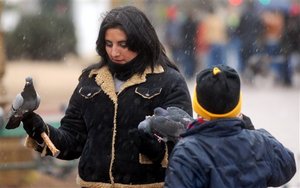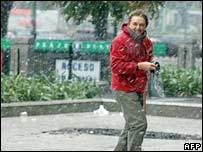
|
| ©AP Photo/Daniel Luna |
| People hold pigeons in Plaza de Mayo as it sleets in Buenos Aires, Monday, July 9, 2007. Argentina is experiencing one of its coldest winters in decades. |
Wet snow fell for hours in the Argentine capital, accumulating in a mushy but thin white layer late Monday, after freezing air from Antarctica collided with a moisture-laden low pressure system that blanketed higher elevations in western and central Argentina with snow.
"Despite all my years, this is the first time I've ever seen in snow in Buenos Aires," said Juana Benitez, an 82-year-old who joined children celebrating in the streets.

|
| ©AFP |
| Wet snow fell for several hours in Buenos Aires. |
Argentina's National Weather Service said it was the first major snow in Buenos Aires since June 22, 1918, though sleet or freezing rain have been periodically reported in decades since.
One man stripped to his shorts to welcome the snow. Children scraped snow of cars and threw snowballs. Motorists honked horns, some with small snowmen on their hoods. Some fender benders were reported on slick suburban streets.
The storm struck on Argentina's Independence Day holiday, adding to a festive air and prompting radio stations to play an old tango song inspired by the 1918 snowfall, "What a night!"
"This is the kind of weather phenomenon that comes along every 100 years," forecaster Hector Ciappesoni told La Nacion newspaper. "It is very difficult to predict."
The snow followed a bitter cold snap in late May that saw subfreezing temperatures, the coldest in 40 years in Buenos Aires. That cold wave contributed to an energy crisis and 23 deaths from exposure.
Two more exposure deaths were reported on Monday.



Reader Comments
to our Newsletter